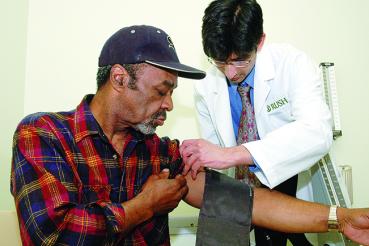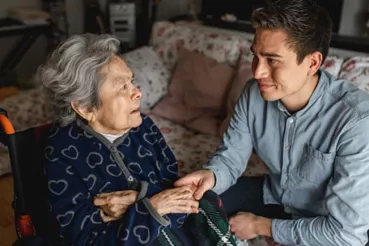In an uncertain world, hot flashes are one of the few things you can count on: A large majority of women have them during menopause.
Menopause begins in your 40s or 50s — at 51, on average. It is a natural process during which your ovaries slowly stop producing eggs and releasing them into your uterus every month. This change disrupts the hormonal shifts that normally come (or came) with your menstrual cycle. In particular, fluctuations in estrogen levels can become more extreme, which affects the way your body regulates heat.
Just before, during and just after menopause, your blood vessels will sometimes constrict and then expand rapidly. These vasomotor spasms, as they are called, start the chain of events that lead to the skin flushing and temperature changes known as hot flashes.
Hot flashes aren't dangerous, and you don't need to treat them if they don’t bother you very much. Eventually, they'll stop on their own: Though some women experience hot flashes into their 60s, the symptoms usually go away after an average of seven years.
But in the meantime, they can be very uncomfortable, and they can prevent you from getting a good night's sleep. It's fortunate, then, that relief is available. Murali Vinta, MD, an OB-GYN at Rush, recommends five ways to find it:
1. Hormone replacement therapy
For many women, hormone replacement therapy, or HRT, is the most effective treatment for hot flashes. "This surprises some people," Vinta says. "There's an idea ingrained in our culture that it's bad for you or that it's dangerous."
In reality, there is very little risk involved with taking hormones in low doses for only a few years. Usually this means taking a combination of progesterone, which helps protect your uterus, and estrogen. If you have had a hysterectomy, you need only estrogen therapy.
You can take these hormones via pills, patches or creams that you apply to your skin, or a ring you insert in your vagina. Regardless of the delivery vehicle, the hormones significantly reduce the frequency of hot flashes for most women who take them.
Of course, over time, hot flashes become less frequent on their own. And in the long term, hormone replacement therapy can increase your risk for heart disease, stroke, breast cancer and endometrial cancer.
So Vinta works closely with his patients, recommending check-ups every six months to a year so that he can ensure they are taking the smallest dose for the shortest length of time necessary to control their symptoms.
2. Medications
For a minority of women, hormone replacement therapy doesn't work. For others, a personal history of heart attack, stroke or breast cancer makes the treatment too risky by increasing the likelihood of dangerous side effects.
In these cases, Vinta often prescribes selective serotonin reuptake inhibitors (SSRI). Typically used as antidepressants, SSRIs have also been shown to reduce hot flashes. One of them, Paxil, is approved by the U.S. Food and Drug Administration for that purpose. And Vinta says other brands of SSRI appear to work similarly well.
In addition, preliminary research suggests that anticonvulsant medications, such as gabapentin and clonazepam, can help some women with hot flashes.
3. Staying cool
No treatment is perfect. "If a woman is waking up 10 times a night with hot flashes, treatment might get her down to three times," Vinta explains. "That makes a huge difference in quality of life. But it doesn't eliminate the symptom completely."
So regardless of whether you take steps to prevent hot flashes, you'll likely need some tactics for responding to them as they happen.
Vinta has a few recommendations:
- Chilled blankets
- Ice packs
- Frozen eye masks
- A cool washcloth held against your neck
- Turning up the air conditioning, if you can
- Dressing in layers, so you can adjust your clothing if you feel a hot flash coming on
"Once a hot flash starts," Vinta says, "only cooling is going to stop it."
The flipside of this equation is that heat can make things worse. Hot environments, spicy foods and cigarette smoke may trigger hot flashes, so it can help to avoid these things.
For many women, hormone replacement therapy, or HRT, is the most effective treatment for hot flashes. This surprises some people. There's an idea ingrained in our culture that it's bad for you or that it's dangerous.
4. Exploring alternative options
Beyond literally staying cool, there are no lifestyle choices or home remedies proven to soothe or prevent hot flashes. But researchers are investigating options that some women have found helpful.
For example, relaxation breathing — deeply breathing in and out for several minutes at a time — may help reduce hot flashes. You can do it anytime: when you feel stressed, for example, or when you feel a hot flash coming on. Other stress-relieving activities, including yoga, qi gong, meditation and mindfulness exercises, may also help.
In addition, one recent study found that women who had acupuncture treatments two times a week for five weeks, plus five additional treatments, had a decline in hot flashes that lasted for 12 weeks following the treatment.
While more research is still needed to determine whether these are effective treatments for hot flashes, none of them is dangerous — and many of them have benefits beyond hot flash reduction. So it's fine to try them and see if they work for you.
The same is not always true of dietary supplements marketed as treatments for menopause, some of which may have harmful side effects.
5. Getting a checkup
If hot flashes are causing you significant discomfort or keeping you up at night, talk to your primary care doctor or OB-GYN.
In addition to helping you find a treatment that works for you, your doctor can determine whether hot flashes are due to menopause, as they are in most cases, or one of the medical conditions (such as hypothyroidism) that can interfere with your body's temperature regulation.




